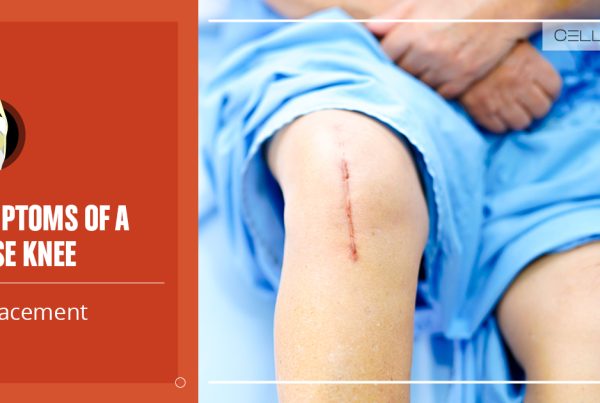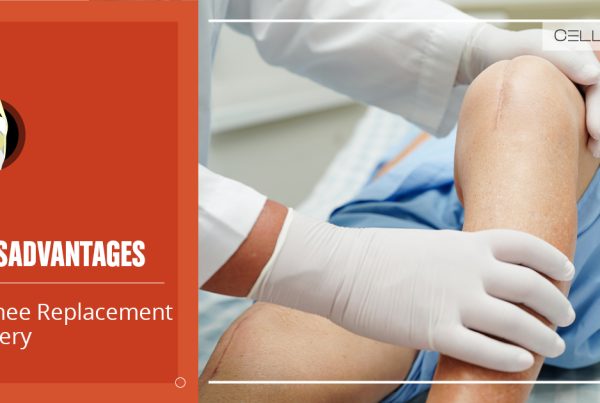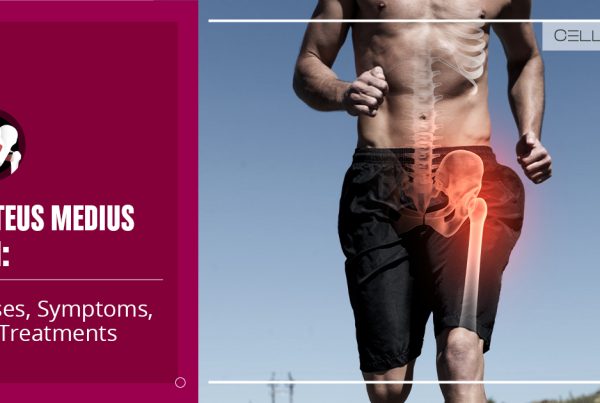Published on: May 4, 2020 | Updated on: January 18, 2025
Knee pain is increasingly becoming prevalent in today’s fast-paced and demanding lifestyle. The knees support our entire body weight, and due to their complex structure and mechanics, they are prone to several ailments and injuries.
Pain or swelling in the knees can cause a lot of discomfort and disrupt one’s day-to-day activities. If you are wondering what is causing the pain on the side of my knee, it can result from various reasons, depending upon the individual’s age, lifestyle, and activity levels.
Do you have Knee Pain?
Fill out the form below to schedule your FREE virtual consultation
Anatomy of the Knee
The knee is the meeting point of the femur (thigh bone) in the upper leg and the tibia (shinbone) in the lower leg. The fibula (calf bone), the other bone in the lower leg, is connected to the joint but is not directly affected by the hinge joint action. Another bone, the patella (kneecap), is at the center of the knee.
Two concave pads of cartilage (strong, flexible tissue) called menisci minimize the friction created at the meeting of the ends of the tibia and femur.
The knee has two menisci:
- Medial: This is the largest of the two on the knee’s inner side.
- Lateral: On the outer side of the knee.
There are also several vital ligaments, a type of fibrous connective tissue, that connect these bones. The four key ligaments of the knee are:
- Anterior Cruciate Ligament (ACL): The front of the knee; this ligament connects the femur to the tibia and is the main stabilizer of the knee.
- Medial Collateral Ligament (MCL): The inside of the knee, the MCL prevents side-to-side movement of the femur.
- Lateral Collateral Ligament (LCL): The outside of the knee, the LCL prevents side-to-side movement of the femur.
- Posterior Cruciate Ligament (PCL): The back of the knee stops the tibia from moving backward in relation to the femur.
There are a variety of causes of side knee pain. The cause can be determined by whether the pain is medial (inside knee) or lateral (outside knee).
Causes of Lateral Knee Pain
Lateral knee pain is often caused by being active in a sport or at work. Certain causes can also be attributed to aging or poor health and obesity.
Lateral Meniscus Injury
This is an injury of the cartilage tissue at the lateral side of the joint. This is caused by awkward knee twisting, especially if the knee is bent while the foot is planted. Gradual onset from wear and tear is also a cause.
Symptoms include:
- Pain in the knee
- Swelling in the knee
- Difficulty straightening the knee
Lateral Collateral Ligament (LCL) Injury
This is knee ligament damage on the outside of the knee. A rapid twisting or awkward fall that forces the lower leg inwards and a hit to the inside of the knee can cause this.
Symptoms include:
- Outer knee pain, swelling in the outer region of the knee
- Bruising
- Instability
- Locking or catching of the knee with movement
Iliotibial Band Syndrome (ITBS)
Iliotibial band syndrome (ITBS) is a widespread and occasionally stubborn knee injury among distance runners and cyclists, which causes outer knee pain. Typically, this knee pain and inflammation comes on gradually and is most prominent when participating in irritating activities.
Symptoms include:
- Knee pain while walking or running due to inflammation on the lateral part of the knee joint.
- Lateral knee arthritis
- Knee discomfort that is dull, achy, and persistent, as well as stiffness (especially in the morning) and creaky/noisy knees
Wear and strain on the outer side of the knee joint, the loss of joint space, the production of bone spurs, and inflammation are all causes. Aging, past injuries, and obesity are all factors that contribute to this.
Proximal Tibiofibular Joint Dislocation
One of the rarest reasons for lateral knee discomfort is proximal tibiofibular joint dislocation. It affects the tibia and the fibula. A considerable force, such as a vehicle collision, is required to dislocate the joint, although it can even partially dislocate from a fall with the foot plantar-flexed (toes pointing down), which frequently destroys the tibiofibular ligament.
Outer knee soreness, instability, especially during deep squats, and an apparent deformity on the side of the knee are common symptoms. Damage to the peroneal nerve may also be present, causing numbness or pins and needles around the outer knee.
Nerve Problems
Outer knee discomfort can also be caused by pressure along the peroneal nerve’s route. The peroneal nerve is a sciatic nerve branch that goes down the outside of the lower leg and into the foot. Tingling, numbness, and pins & needles are common symptoms of nerve discomfort.
A hit to the side of the knee, which squashes the peroneal nerve just beneath the skin, is the most common cause of peroneal nerve damage. Alternatively, if the sciatic nerve splits off from the lower section of the lumbar spine, there may be pressure further up the nerve.
Discomfort on the outside of the knee, with or without back pain, can be caused by the pain traveling down the nerve.
Causes of Medial Knee Pain
The most common cause of medial knee discomfort is cartilage degradation. It can also occur due to a sports injury or knee damage.
Medial Meniscus Injury
The meniscus is cartilage that provides a cushion between bones in a joint. They serve as cushions between the thigh and shin bones.
A meniscus can tear or become damaged if the knee is rotated or put under pressure, most commonly during sports or athletic activities.
Symptoms include:
- Stiffness
- Sharp pain when twisting the knee
- Locking knees
- Sense of imbalance
Medial Collateral Ligament (MCL) Injury
The medial collateral ligament (MCL) stabilizes the knee joint by running outside the inner knee. An MCL sprain can happen if the ligament extends too much.
The MCL can entirely or partly tear. Injuries to the MCL are most likely when an impact is applied to the outside of the knee, such as in contact sports.
Symptoms include:
- Inflammation
- Instability while walking or standing
- Locking knees
- At the moment of impact, there is a popping sound
Osteoarthritis
Osteoarthritis is a degenerative condition that causes the bones in the joints to grind together as cartilage breaks down.
Someone with osteoarthritis may have inner knee discomfort while applying pressure on the joint, such as when going up and down stairs or sitting in a chair. Because the pressure causes the pain, symptoms may get more severe as the day progresses.
Rheumatoid Arthritis
Rheumatoid arthritis is an auto-immune illness that can cause discomfort inside the knee. Because rheumatoid arthritis produces inflammation in the joints, rheumatoid arthritis patients may have acute inner knee discomfort in the morning, with symptoms gradually diminishing over the day.
Irritation of the Medial Plica
Plica is a term used to describe tiny folds in the joint lining. The medial plica covers the inside knee. The medial plica can be irritated by overuse, such as continually bending the knee.
The folds thicken and become caught between the bones due to this. Locking knees and maybe a snapping sound are possible side effects of mild inner knee discomfort.
Less Common Causes of Knee Pain
Although knee pain occurs mainly due to injuries or arthritis, there are specific other subtle causes. These include
Referred Pain from Hip or Lower Back
At times, the knee pain isn’t caused directly by the knee itself. It is referred to from another area, such as the lower back, hip joint, or herniated disc. All these can cause pain around the knee as well. It will feel like shooting pain that passes through your leg.
The course of treatment will, of course, require a proper diagnosis of the origin of the pain and will be addressed through medication, physical therapy, or exercises to alleviate the pain.
Tendonitis
Tendonitis occurs when the tendon that connects the bones and joints gets inflamed.
The quadriceps and hamstrings may be affected due to repetitive movement, overuse, or extensive activity. The pain is usually felt in the front of the knee but may extend to the other side through increased movement and activity.
Over time, it gets worse, and you may also feel tenderness in the region.
Nerve Compression or Damage
Nerve compression can also lead to knee pain. The nerves that run from the side of the knee all the way down may become compressed due to extreme pressure or an injury. As a result, you experience a burning pain or numbness.
The treatment will depend on how the bad symptoms are, and you may need complete nerve decompression or physical therapy to reduce the pressure.
Diagnosis
The key here is proper diagnosis to identify the actual cause of the pain, and that will determine the course of action. Usually, healthcare professionals conduct different exams to identify the cause.
The doctor will check the range of motion, tenderness, swelling, and instability in the leg. They may ask about your history of injuries and any recent strenuous activity.
Further tests like X-rays and MRI will also be conducted to check for bone-related issues like osteoarthritis or bone fracture.
Ultrasound and CT scans can further help look into soft tissue damage and conditions like bursitis or tendonitis.
When to Seek Medical Attention
If you feel intense pain or swelling, consult a doctor asap. Severe pain can indicate injury like a ligament tear or fracture. It requires immediate action and evaluation by the healthcare professional.
Another thing to look out for is if your knee feels locked, keeps getting stuck, or if the pain doesn’t improve with time and rest. Do not delay seeing your healthcare provider.
Treatment for Pain on the Side of the Knee
The underlying source of the pain will determine the optimum therapy for lateral and medial knee pain. Physical therapy, exercises, and rest from aggravating activities are typically used. However, knee injections may also involve autologous stem cells or platelet-rich plasma (PRP).
Stem cells and PRP can help reverse the degenerative effects of certain causes of knee pain, such as arthritis. It is also effective in healing ligament and muscle tears and can prevent a patient from needing surgery for more severe knee injuries.
Regenerative sports medicine and orthopedic procedures have had significant advancements in the past ten years. These procedures have excellent outcomes on a wide array of issues with the knee.
Sources
Footnotes
- Jacobus M. The pain in the patient’s knee. Diacritics. 1998;28(4):99-110.
- Chang KV, Hsiao MY, Hung CY, Özçakar L. An uncommon cause of posterior knee pain: diagnosis and injection for popliteus strain using ultrasonography. Pain Medicine. 2016;17(4):795-6.
- Boudreau SA, Royo AC, Matthews M, Graven-Nielsen T, Kamavuako EN, Slabaugh G, Thorborg K, Vicenzino B, Rathleff MS. Distinct patterns of variation in the distribution of knee pain. Scientific Reports. 2018;8(1):16522.
- Horan J, Quin G. Proximal tibiofibular dislocation. Emergency Medicine Journal. 2006 May 1;23(5):e33.
- Bauer TW. Stem cell therapy for knee pain—what exactly are we injecting, and why?. JBJS. 2016;98(18):1509-10.
- Davatchi F, Sadeghi Abdollahi B, Mohyeddin M, Nikbin B. Mesenchymal stem cell therapy for knee osteoarthritis: 5 years follow‐up of three patients. International journal of rheumatic diseases. 2016;19(3):219-25.
References
- Meniscus Tear of the Knee. Healthline. Accessed 2/23/2024.
- Menisci of the knee joint. MyHealth.Alberta.ca. Accessed 2/23/2024.
- Iliotibial Band Syndrome (ITBS). BraceAbility. Accessed 2/23/2024.
- Peroneal Nerve. Mayo Clinic. Accessed 2/23/2024.
- Plica Syndrome. Physiopedia. Accessed 2/23/2024.
CELLAXYS does not offer Stem Cell Therapy as a cure for any medical condition. No statements or treatments presented by Cellaxys have been evaluated or approved by the Food and Drug Administration (FDA). This site contains no medical advice. All statements and opinions are provided for educational and informational purposes only.
Dr Pejman Bady
Author
Dr. Pejman Bady began his career over 20 years ago in Family/Emergency Medicine, working in fast-paced emergency departments in Nevada and Kansas. He has served the people of Las Vegas as a physician for over two decades. Throughout this time, he has been met with much acclaim and is now the head of Emergency Medical Services in Nye County, Nevada. More about the doctor on this page.
Dr Pouya Mohajer
Contributor
Pouya Mohajer, M.D. is the Director of Spine and Interventional Medicine for CELLAXYS: Age, Regenerative, and Interventional Medicine Centers. He has over 20 years of experience in pain management, perioperative medicine, and anesthesiology. Dr. Mohajer founded and is the Medical Director of Southern Nevada Pain Specialists and PRIMMED Clinics. He has dedicated his career to surgical innovation and scientific advancement. More about the doctor on this page.









